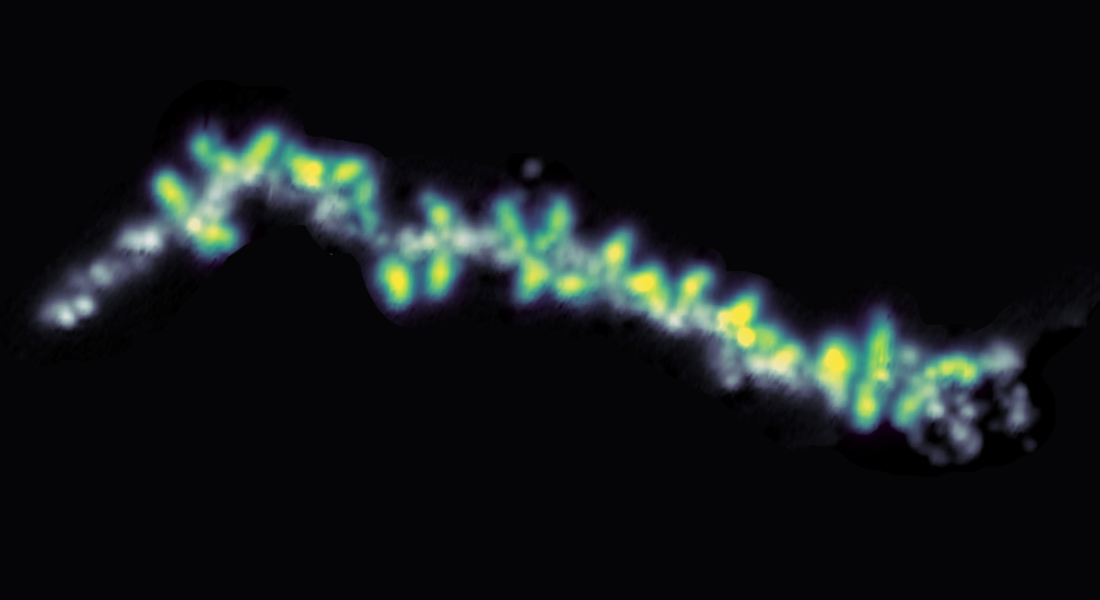The first picture of a protein with sugars
For the first time researchers snap a picture of a protein with sugars attached. This has great potential and could advance our comprehension of the microbiome and the development of new sugar-based therapeutics.

Proteins are the major building block of the human body. Often these proteins are covered by sugars. We can study the individual parts and composition of these, but we have not been able to see them.
Therefore, it is groundbreaking that researchers from the University of Copenhagen and Max Planck Institute have taken the first picture of a protein with sugars.
The most complex sugar molecule we managed to analyze is what we commonly call slime, comprised of mucins molecules that coats all wet surfaces of our body, serving as a protective barrier between the microbiome and our body
“An advanced microscopy technique allows us to visualize glycoproteins with full structure of the protein backbone and the glycan attached to this,” says Associate Professor Rebecca Miller from the Copenhagen Center for Glycomics at the Department of Cellular and Molecular Medicine.
The sugars covering proteins, also called glycans, exert many critical functions in the body such as regulating immunity, clotting functions, growth and development, and containing and feeding the microbiome in healthy symbiosis with the human.
“However, most techniques to study proteins fail to visualize the glycans attached. But with our new study, we show that it is possible,” says Rebecca Miller.
Like going to the moon
Predicting the specific implications of this visualization technique for the future is a complex endeavour, yet its potential is undeniably immense, notes Rebecca Miller and adds:
“It’s like going to the moon. When we first developed rockets, we couldn't foresee the full scope of the impact of the journey. However, it underscores the importance of unraveling the mysteries of the world around us. Over the last few centuries of research, we've learned that understanding how things work ultimately leads to innovative applications.”
One compelling application of this new imaging technique lies in unraveling the complexities of the human microbiome. Within our bodies, a diverse array of bacteria coexists, collectively forming the microbiome in the intestine. Some of these bacteria are beneficial, while others are not.
“The most complex sugar molecule we managed to analyze is what we commonly call slime, comprised of mucins molecules that coats all wet surfaces of our body, serving as a protective barrier between the microbiome and our body,” says Associate Professor Yoshiki Narimatsu, who contributed to the study by producing the mucin molecules.
So, the layer of sugar molecules plays a part in keeping out the bad bacteria.
“The microbiome is extremely important for our bodies. We cannot live without it, because it digests our food so we can get essential amino acids, metabolites, and other nutrients. Research over the past decade has strongly suggested that many diseases are somehow influenced by the microbiome for example diabetes. Our new technology opens the door to potentially manipulating the microbiome to combat diseases in the future,” he says.
Besides paving the way for understanding how mucins control the microbiome, the new study could also make it possible to help with medicine production.
“Most of the proteins that we inject people such as, antibodies to cure cancer or and hormones like erythropoietin (EPO) to stimulate blood formation. All these drugs, have sugars on them,” says Professor Henrik Clausen and Yoshiki Narimatsu adds:
“And every time a medicine company makes a batch of these drugs, they must test the quality and match the sugars. In principle using this new technology, they could look directly at each molecule and their sugars.”
Now the researchers want to use the new technology to study how mucins in the slime control the microbiome and maintain a healthy state of symbiosis. They already know that sugars are critical for selecting the beneficial bacteria and clearing the bad, but being able to see these effects at the individual molecules should open a new world.
You can read “Direct observation of glycans bonded to proteins and lipids at the single-molecule level“ in Science.
The project was partly funded by the Danish National Research Foundation and Novo Nordisk Foundation.
Contact
Professor Henrik Clausen
hclau@sund.ku.dk
+4535335485
Associate Professor Rebecca Miller
rmiller@sund.ku.dk
+4535331841
Associate Professor Yoshiki Narimatsu
yoshiki@sund.ku.dk
+4535335528
Journalist and press consultant Liva Polack
liva.polack@sund.ku.dk
+45 35 32 54 64
